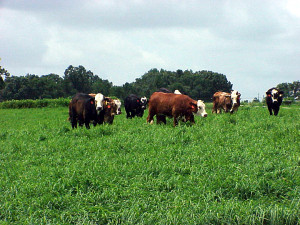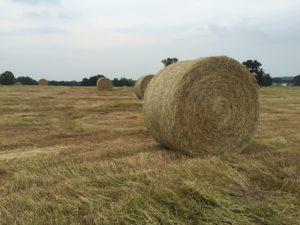Preparing for the Next Drought
If your crystal ball is not working it is always better to be safe than sorry when it comes to a potential drought because another drought will occur, the prediction is when. Some best management practices can prepare us for a potential drought: forage management, grazing management and utilization of warm-season annual forages.
Forage management: It is always important, drought or not, to pay attention to plant nutrient requirements. Soil test, apply the needed fertilizer and hope for rain. Ensure soil pH is adequate to enhance fertilizer uptake efficiency. Applying nitrogen fertilizer just prior to times when conditions are likely to be optimum for forage growth, such as the beginning of the growing season, helps to maximize its utilization. In periods of limited soil moisture, delaying fertilizer application until moisture is present or imminent can also increase efficiency. When rain falls, pastures should be well fed and ready to grow. If not managed properly during drought recover, invasive species will take over and once established will be difficult to get rid of.
Grazing management: Heavy grazing during drought can severely stress plants. Even prior to a drought, heavy grazing reduces the root mass and can make the plants less efficient at utilizing any nutrients and moisture in the soil. It may be necessary to remove livestock from pastures and feed stored feed for some time. Those without adequate facilities may have to establish a sacrifice paddock where feeding can take place. Using a rotation stocking management system allows flexibility for this practice. Using a sacrifice paddock will limit the damage to only one pasture as opposed to multiple areas. Animals could also be fed in alleyways and/or lanes. If feeding livestock in other locations, make sure water is always available. If destocking has occurred due to a drought, consider maintaining herd size at that number. It is much more economical to harvest hay from excess forage during good times than it is to feed stored forage and supplement during a drought.
Warm-season annuals: Summer annual grasses should be considered as temporary solutions to summer forage needs. They can be expensive to produce, difficult to manage, and have a potential for prussic acid and/or nitrate poisoning of livestock. Some desirable characteristics include rapid growth, excellent drought tolerance, and good response to fertilizer and water. The most efficient and economical use of these grasses is in a management-intensive rotational grazing system. Summer annuals can be an excellent option in dry years.
Summer annual grasses that can be grown in Texas include sudangrass (Sorghum bicolor), forage sorghum (Sorghum bicolor), sorghum x sudangrass hybrids, pearl millet (Pennisetum americanum), and crabgrass (Digitaria sanuinalis). These forages can be valuable in the development of a forage system. Each of these has unique growth characteristics that require proper management for optimum production.
Pearl millet is better adapted to sandy, acid soils than forage sorghum. Plantings can be made in the spring by simply broadcasting or drilling at a soil depth of 1/2 to 1 inch. Pearl millet will regrow after harvest if a 5-inch stubble height is left. Be careful not to graze or mow pearl millet too closely because it can be killed. It will take about 4 to 6 weeks of regrowth before it is ready for the next harvest. Grazing can be continued until frost is expected. Pearl millet has a distinct advantage over sorghum, sudangrass, and sorghum x sudangrass hybrids, it does not produce prussic acid. However, millet as well as sorghums can cause nitrate poisoning.
Sorghums are a class of warm season annual grasses in which several forage types have been developed. Forage sorghums are best adapted to fertile, well-drained soils that have good water holding capacity. It is the most drought tolerant of the warm-season annuals mentioned in this paper. Before grazing, sorghum should be at least 30 inches tall and grazed to a stubble height of 5 to 7 inches. Forage sorghums are best used in a single hay cutting when plants are in bloom or early dough stage. A mower-conditioner will be needed to crush the stems to decrease drying time.
Sudangrass is a rapid growing warm-season annual that can produce good quality forage if management appropriately. True sudangrass has fine stems and grows rapidly after grazing. They are usually lower yielding compared with sorghum-sudangrass hybrids. Sorghum-sudangrass hybrids have the highest yield potential of any of the summer annuals. Sorghum-sudans can be used for grazing or silage, but like other annual sorghums, their forage is very difficult to dry to moistures suitable for hay production. If grazed, the sorghum-sudans should be rotationally grazed allowing regrowth height to reach 24 inches before grazing.
Be aware that both millet and sorghum-sudan plants can accumulate nitrates during drought, so test hay before feeding and graze pastures cautiously. Nitrates will persist in forages cut for hay. If hay is suspected of having high nitrate levels, it should be sampled and tested. Your local County Extension Office can provide information on hay sampling and advice on using hay with high nitrate levels. In addition to grazing, these crops can be harvested as green chop, silage, or hay. Feeding green chop requires the same precautions as grazing to prevent prussic acid and/or nitrate poisoning, Silage or hay is easiest to cure when the plants are in the boot stage; however, yield and sugar for rapid fermentation of silage are greater at the soft dough stage. A conditioner must be used to crush the stems to ensure quick drying for hay.
Crabgrass is commonly considered a weed, however it possesses significant potential for supplying high quality summer forage. Crabgrass is best adapted to well-drained soils such as sand, sandy-loam, loamy-fine sand, loams and silt loams. It is best utilized in a rotational grazing system.
Summer annuals need a good supply of nutrients to make high yields. Lime, phosphorus and potassium should be applied according to soil test recommendations. Nitrogen is important and should be added at the rate of 60 to 100 pounds per acre at green up. If additional harvests are planned, 40 to 60 pounds of nitrogen per acre may be added after each harvest. Warm season annuals do require annual land preparation, planting and fertilization. They may not be economical with high diesel, seed, fertilizer, and irrigation prices. If summer precipitation limits or prevents hay production, winter annuals are the cattleman’s next option.
Managing for drought is complex and must take place throughout the calendar year. Be sure to graze properly in the summer and plan ahead for fall, winter and spring forage production so that feeding of expensive hay or supplements in minimized.
Vanessa Corriher-Olson
Professor, Forage Extension Specialist
Soil & Crop Sciences
Texas A&M AgriLife Extension, Overton,TX
903-834-6191

